
|
Designing the JG Rank Insignia
16 September 2003
A special behind-the scenes look at how the JG Enterprises rank insignia were designed.
There's a lot of images, so allow it time to load.
This article is divided into six sections. You can skip to each section using the links below:
- Introduction
- Flag Officers
- Line Officers
- Enlisted Personnel
- Warrant Officers
- End Notes
Introduction.
Ever since its humble beginnings as JG Labs, the über-organization JG Enterprises has been structured with a system of ranks. The rank system maintains the chain of command and keeps an order amongst personnel. Based off the U.S. Navy's system, personnel were divided into two primary areas: Enlisted personnel and commissioned officers. Enlisted personnel would have a temporary duty status, assigned to a specific task. Commissioned officers have long-term careers with JG Enterprises, and are assigned to governing and maintaining the organization. Lower ranking officers are called Line/Staff Officers (Line Officers handle general duties while Staff Officers are more specialized), while high ranking officers are called Flag Officers. The rank structure is as follows:
Enlisted
Personnel
| Warrant
Officers
| Commissioned
Officers
|
E-1: Crewman Recruit
E-2: Crewman Apprentice
E-3: Crewman
E-4: Petty Officer, Third Class
E-5: Petty Officer, Second Class
E-6: Petty Officer, First Class
E-7: Chief Petty Officer
E-8: Senior Chief Petty Officer
E-9: Master Chief Petty Officer
|
W-1: Warrant Officer
W-2: Chief Warrant Officer
W-3: Chief Warrant Officer
W-4: Chief Warrant Officer
W-5: Chief Warrant Officer
|
Line Officers:
O-1: Ensign
O-2: Lieutenant, Jr. Grade
O-3: Lieutenant
O-4: Lieutenant Commander
O-5: Commander
O-6: Captain
Flag Officers:
O-7: Rear Admiral (Upper)
O-8: Rear Admiral (Lower)
O-9: Vice Admiral
O-10: Admiral
O-11: Fleet Admiral
|
The U.S. Navy's rank structure
The U.S. Navy's rank insignia, for comparison with mine featured below, can be referenced on the Navy's website.
JG Labs' rank structure was defined by colors, integrated into an officer's uniform. It was also a very highly simplified version of the Naval system.
| Ensign |
Lieutenant |
Lieutenant
Commander |
Commander |
Captain |
Admiral |
Fleet
Admiral |
JG Labs' officer rank colors.
In time, JG Labs became JG Enterprises and gained not only a more expansive system of rank, but also newly designed insignia to indicate the status of the wearer. This is how they were designed, in the order that I did them.
Flag Officers.
The Flag Officer's rank insignia were the first to be created. Flag Officers, the five levels of Admiralty, are the highest ranks in the system. These insignia were created almost offhandedly one evening while I was trying to design an Admiral's dress uniform. Not having any better insignia at the moment, I added a series of three arches on the upper arms of both sleeves. Despite knowing that stripes that high up on the sleeve would be better suited to Enlisted crew, I still thought these three stripes showed promise. It didn't take much more thought to think of a system in which these may fit.
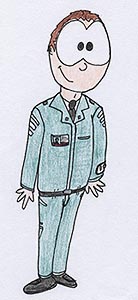
Dress uniform concept, showing three rank stripes.
21 February 2001
Naval admirals in "Real Life" tend to savor fours: Four stars, four stripes. I think it makes an interesting change to have a full admiral have only three stripes. Lower Rear Admirals begin with three 1-inch stripes. A 2-inch stripe replaces a 1-inched for Upper Rear Admirals, and Vice Admirals have two 2-inch stripes and one 1-inch. A full Admiral then ends up with three 2-inch stripes.
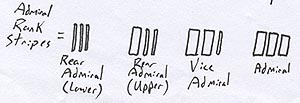
First (and only) pass at the Flag Officer ranks.
21 February 2001
Once I had the system down, I could then design the actual insignia that Flag Officers would wear on their uniforms. Almost as easily as the rank system had come together did the appearance of the insignia appear: I simply took the existing three bars, placed them over a rectangular back piece and stuck a JG emblem on the middle bar. Two days after I had the Flag Officer system created did I have the insignia finished as well. These epaulets would be worn on the shoulders of the uniforms. When I did the collar devices, I simply shrunk the large epaulets down and removed the JG from the center.

Original sketch of the Flag Officer insignia
23 February 2001
Once I had the insignia and rank system designed, I drew them on the computer. I hadn't given thought to the Fleet Admiral's insignia, but I solved that dilemma by placing an eight-pointed star atop the Admiral's insignia. The eight points would reach to the four corners as well as the middle of each side. Fleet Admirals are only appointed in special conditions, such as times of war. Since the Fleet Admiral insignia wouldn't see much use anyway, its appearance was not as important as the preceding four. I still like how it looks, though. Once completed, here is how the Flag Officer rank insignia looked:

Flag Officer rank insignia
Rear Admiral (Lower), Rear Admiral (Upper), Vice Admiral, Admiral, and Fleet Admiral
Line Officers.
The Line Officer rank insignia gave me more difficulty than the Enlisted and Flag Officers combined. The U.S. Navy's insignia can be, quite frankly, confusing to say the least. It does have order, but there are three different orders in the span of six ranks. Ensigns have a gold bar, Lieutenant (Junior Grades) have a silver bar, while Lieutenants have two silver bars. Lieutenant Commanders then have a gold oak leaf and Commanders have a silver oak leaf. Captains are given a spread eagle bearing the federal shield and olive branch. My goal was to create a rank system that went from Ensign to Captain much more evenly.

US Navy Line Officer Insignia
20 September 2001
After contemplating the Navy's insignia and the Star Trek movie-era ranks, I began a series of three quick doodles, just testing ideas. These were little more than simple line drawings to establish a train of thought.

Line Officer first pass doodles
20 September 2001
All well and good, but they needed fleshing out and more thought. I wound up creating a series of ten sets of rank insignia. The three line drawings above became numbers 3, 4, and 5 in the detailed drawings below. Ensigns are on the left, traveling up to Captains on the right.
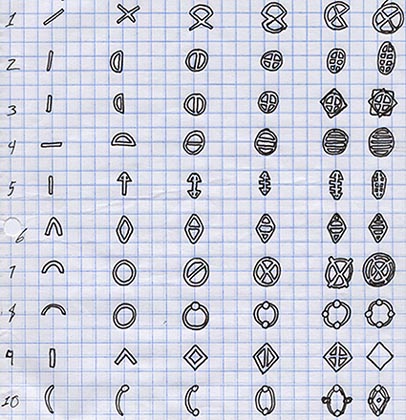
Line Officer second pass drawings
20 September 2001
Numbers 1 and 7, in retrospect, probably would not work because they resemble the X-Men logo. Numbers 2 and 5 were dropped due to the difficulty I would have making them into physical pieces. Incidentally, I thought that number 5 also looked too much like a fish skeleton. Number 9 is probably the most logical given a military point of view, but JG is not the military.
With Jeff's opinions, I whittled the choices down to number 4 (which I called "the sewer grate") and number 6, which I finally decided upon. But before I made that deciding choice, I produced two color versions of the "sewer grate" insignia in order to decide whether I wanted a silver insignia on a gold background or a gold insignia on a silver background. As the checkmark notes, the former won out.

Line Officer insignia color test
20 September 2001
The rank insignia I finally decided on was lozenge-shaped, and featured bars running lengthwise across its open face to show the rank. Captains in the U.S. Navy wear four stripes on their sleeves. This caused me to have four bars across my own Captain's rank. Beginning with a chevron (a deliberate nod to Army Insignia), a full lozenge is formed by Lieutenant (Junior Grade), then adding a bar across as you work towards Captain. This system seemed to follow a more logical pattern than the Navy's did (although I do understand the Navy's tradition regarding their ranks). I decided to change the concept by giving the lozenge pointed corners rather than rounded.
Before I could draw the fully detailed versions of the insignia, I first needed to decide on the scaling of the lozenge. How wide it would be compared to its height, and what size would the actual piece be. I did a scale drawing showing four different versions worth considering. I wound up using number 3:
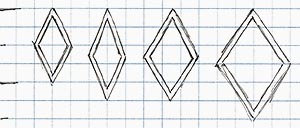
Line Officer scaling drawing
21 September 2001
With the design and scaling decided, I was finally able to create a full color drawing of my brand new Line Officer rank insignia!

Line Officer final drawing
22 September 2001
Line Officer epaulets came later that week as I tried another uniform concept. They're little more than the insignia attached to a rectangle with the JG emblem. The entire epaulet is silver, even the part that's gold on the collar devices.
 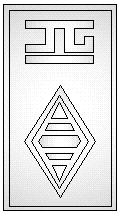
Line Officer epaulet concept and final
29 September 2001
As with the Flag Officers, I drew the new insignia on the computer for use on the JG Enterprises website. During the process of drawing them on the computer I made a mistake (don't ask me how) and accidentally created a Lieutenant insignia that consisted of two separate triangles rather than the lozenge with a bar through it that I had designed. The erroneous rank is shown below.

Incorrect Lieutenant insignia
It only took two days to design them, but a lot of thought went into creating the JG Enterprises Line Officer rank insignia.

Line Officer rank insignia
Ensign, Lieutenant (JG), Lieutenant, Lieutenant Commander, Commander, and Captain
Enlisted Personnel.
For all intents and purposes, the enlisted personnel insignia was the first to be designed, but was not fully realized until after the Flag Officer insignia had been completed. My first passes at Enlisted insignia yielded a different result than what I was to end up with. In November 1999, I designed an Enlisted person's uniform, based very closely on the Navy's, right down to the rate insignia (Enlisted personnel have rates, not ranks). The figure I drew featured three diagonal stripes on the upper arm, much like a Seaman in the Navy, and below I drew two stripes (E-2) at actual size. I later decided that this was far too similar to the Navy for my tastes.
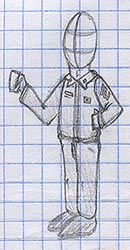 |
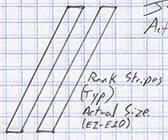 |
First pass at an Enlisted Uniform
13 November 1999 |
First pass at Enlisted rates
13 November 1999 |
|
It wasn't until the Summer of Bad Tidings that I created the concept for the JG enlisted insignia. Enlisted persons in the armed forces often wear chevrons, or designs on them. I thought it would be neat to base my system on circles, and with that idea created "rank rings," based fairly closely on the Navy's inverted chevrons (i.e., 'V' shaped). I created the Petty Officer rates, figuring I would worry about the first and last three later.
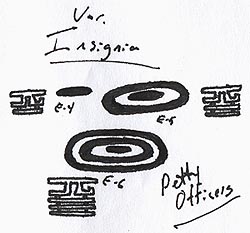
Enlisted Personnel First Pass
13 September 2000
When I finally did get back to the Enlisted rates, it was some nine months later, I had thought them out fully enough that I didn't feel the need to produce sketches of my ideas as I had the Officer insignia. Instead, I sat right down at the computer to draw the rank rings from start to finish. Using my earlier sketch as a starting point, I worked backward to create the first three. The Navy uses the term "Seaman" to describe the first three Enlisted rates, but I went with the more general "Crewman," being that I wasn't at sea. Crewman Recruit has no ring. Crewman Apprentice has one ring, while Crewman has a solid oval.

Enlisted Personnel, E-1 - E-3
Crewman Recruit, Crewman Apprentice, and Crewman
Following that are the Petty Officer rates. Petty Officer Third Class has one ring around the oval. Second Class features two rings, while Third Class has three. You'll notice that this differs from the concept, where the solid oval was for Petty Officer Third Class.

Enlisted Personnel, E-4 - E-6
Petty Officers Third Class, Second Class, and First Class
Chief Petty Officers in the Navy close off their chevron and begin adding stars. My insignia feature solid circles rather than stars. Chief Petty Officers have one, Master Chiefs have two, while Senior Chiefs have three circles.

Enlisted Personnel, E-7 - E-9
Chief, Senior Chief, and Master Chief Petty Officers
Being that Enlisted Personnel are specialized in a particular field, their rating (akin their job) is represented by a graphic within the rank rings. I've done a couple designs for these in the past, but haven't had much reason to fully design a complete series of these little pictures. I guess they'll come up as needed. The rating in the above graphics is the rate of Engineer's Mate (that's a little warp core from Star Trek). Along with my original concept sketch above, I also did a couple ideas for ratings, shown below. My favorite is the little ray gun.
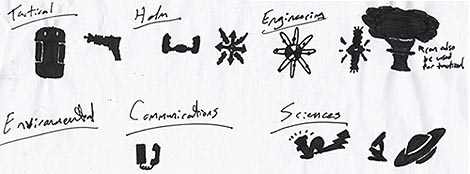
Enlisted Personnel rating sketches
The collar devices were based on the JG emblem. Their assembly was inspired by the Navy's Lieutenant double bars (see above). Crewman rates do not feature the underline bar, which Petty Officers receive (as per their rank rings). Chief Petty Officers widen the lowest bar and add however many circles their ring has.
 |
 |
 |
Crewmen
rates |
Petty Officer
Second Class |
Master Chief
Petty Officer |
Examples of Enlisted collar devices
Warrant Officers.
When a Chief Petty Officer manages to become a specialist in his or her field, then they may apply for a special commissioning, and become a Warrant Officer. While not a fully commissioned officer, they are still entitled to much of the respect given to officers. JG Enterprises does not have enough personnel to make a Warrant Officer position conventional. Nevertheless, I still did a quick sketch of a possible Warrant Officer rank. It's similar to the insignia Warrant Officers in the armed forces wear. There are four colored squares (the JG makes up the top square), and however many squares are colored depends on which of four ranks of Warrant Officer is being represented. This is as far as I ever got with Warrant Officers.
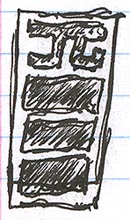
Warrant Officer concept sketch
7 March 2002
During the writing of this article, I became aware that a fifth Warrant Officer rank had been created by the Navy in 2002. If I ever decide to pursue Warrant Officer ranks, I will likely keep with the original four-rank system.
End Notes.
The complete listing of all the JG Enterprises rank insignia can be found on the rank page at the JG Enterprises website.
Thank you for reading my article on designing the JG rank insignia. It's an article that I've wanted to write for quite a while now, and I hope that you found it interesting. Creating these insignia was a fun process to go through, and I've enjoyed sharing it with you.
 Articles Articles
|
 |

